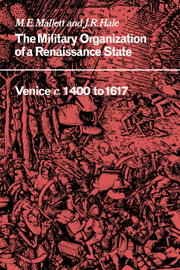Book contents
- Frontmatter
- Contents
- List of illustrations
- Acknowledgements
- References and abbreviations
- Map 1 The Terraferma in the fifteenth and sixteenth centuries
- Map 2 The empire da Mar
- PART I c. 1400 to 1508
- PART II 1509–1617
- 8 The historical role of the land forces 1509–1617
- 9 The wars
- 10 Government: policy, control and administration
- 11 The higher command
- 12 Manpower
- 13 Cavalry, infantry, artillery
- 14 Fortifications in the Terraferma
- 15 The defence of the maritime empire
- 16 The costs of defence and war
- Conclusion: the European context 1525–1617
- Appendix Infantry wages in the sixteenth century
- Select bibliography
- Index
8 - The historical role of the land forces 1509–1617
Published online by Cambridge University Press: 22 October 2009
- Frontmatter
- Contents
- List of illustrations
- Acknowledgements
- References and abbreviations
- Map 1 The Terraferma in the fifteenth and sixteenth centuries
- Map 2 The empire da Mar
- PART I c. 1400 to 1508
- PART II 1509–1617
- 8 The historical role of the land forces 1509–1617
- 9 The wars
- 10 Government: policy, control and administration
- 11 The higher command
- 12 Manpower
- 13 Cavalry, infantry, artillery
- 14 Fortifications in the Terraferma
- 15 The defence of the maritime empire
- 16 The costs of defence and war
- Conclusion: the European context 1525–1617
- Appendix Infantry wages in the sixteenth century
- Select bibliography
- Index
Summary
Throughout the sixteenth century the Mediterranean was dominated by the Ottoman Turks, Spain and Venice. All were imperial powers. Only one, however, was named after a mere city. Remarkable as had been the creation of the Venetian empire overseas, more remarkable still was its survival. And this was dependent on the retention by Venice of control over its second, later empire, that of the mainland. After wars that left by 1530 the other political units of Italy either the subjects or the nervous satellites of Spain, Venice, uniquely, maintained its independent status.
This independence added a final element to the pre-existing admiration for the stability and rationality of the city's constitution and for the harmony that prevailed among its social groups. Exaggerated both by the republic's own propaganda and the envy of other states, these elements formed the core of what has been dubbed the Myth of Venice. But this myth could not have elicited the fascinated admiration of other states, even of imperial powers like seventeenth-century England and the Netherlands, had Venice itself not remained the capital of an empire. Slight as its presence was to become among the burly contestants of the European political scene, Venice's power over the imagination was due to its power by land and sea. And at the base, the fulcrum of that power, were the armed forces, the republic's soldiers.
- Type
- Chapter
- Information
- The Military Organisation of a Renaissance StateVenice c.1400 to 1617, pp. 212 - 220Publisher: Cambridge University PressPrint publication year: 1984



